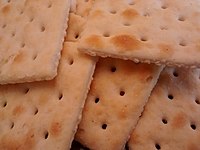Premium Plus
This article has multiple issues. Please help improve it or discuss these issues on the talk page. (Learn how and when to remove these messages)
|
 | |
 | |
| Product type | Cracker |
|---|---|
| Owner | Mondelez International |
| Country | U.S. |
| Introduced | 1876 |
| Previous owners | Nabisco |
| Website | snackworks.com/premium |
Premium (Premium Saltine Crackers) is a brand of soda cracker produced by Nabisco, which were first introduced in 1876.[1] It is known as Premium Plus (Premium Plus Salted Tops) in Canada, under the Christie (formerly, Mr. Christie) banner. In the United States it is marketed as "Original Premium."[2]
It is currently sold in these flavours: Unsalted (Original), Salted, Five Grain, and Whole Wheat.[3]
The crackers are square in shape but round versions have been marketed as well.[4]
Packaging
[edit]The crackers are typically sold in boxes containing 4 "sleeves" of crackers sealed in plastic inside, for the home consumer. Larger packages containing 8 or 12 "sleeves" are also available. Bulk packages of individualized servings containing two or four crackers are also available, and are frequently used at restaurants. Occasionally the crackers are sold in tin cans.
Boxes are red in Canada and white in the United States.
Controversy
[edit]In 1989, Phil Sokolof, an Omaha millionaire published ads in the Los Angeles Times accusing Nabisco of including unhealthy saturated fats in its products. At the time, Nabisco Saltine Crackers still contained lard, a semi-solid white fat product obtained by rendering the fatty tissue of a pig.[5] At some point in the 1990s the company switched to a more vegetarian-friendly vegetable oil.
References
[edit]- ^ Burkhalter, Bettye (2012). Raised on old-time country cooking: a companion to the trilogy. AuthorHouse. p. 108. ISBN 978-1-4685-4081-9. Retrieved 10 March 2024.
- ^ "Original Premium". Snackworks.com. Retrieved 31 July 2021.
- ^ "Premium Plus Products". Snackworks.ca. Retrieved 12 February 2019.
- ^ "Premium Plus". Snackworks.ca. Retrieved 12 February 2019.
- ^ Health Crusader Targets Nabisco in Latest Battle Over Use of Tropical Oils, from the LA Times, 2 March 1989.
External links
[edit]
